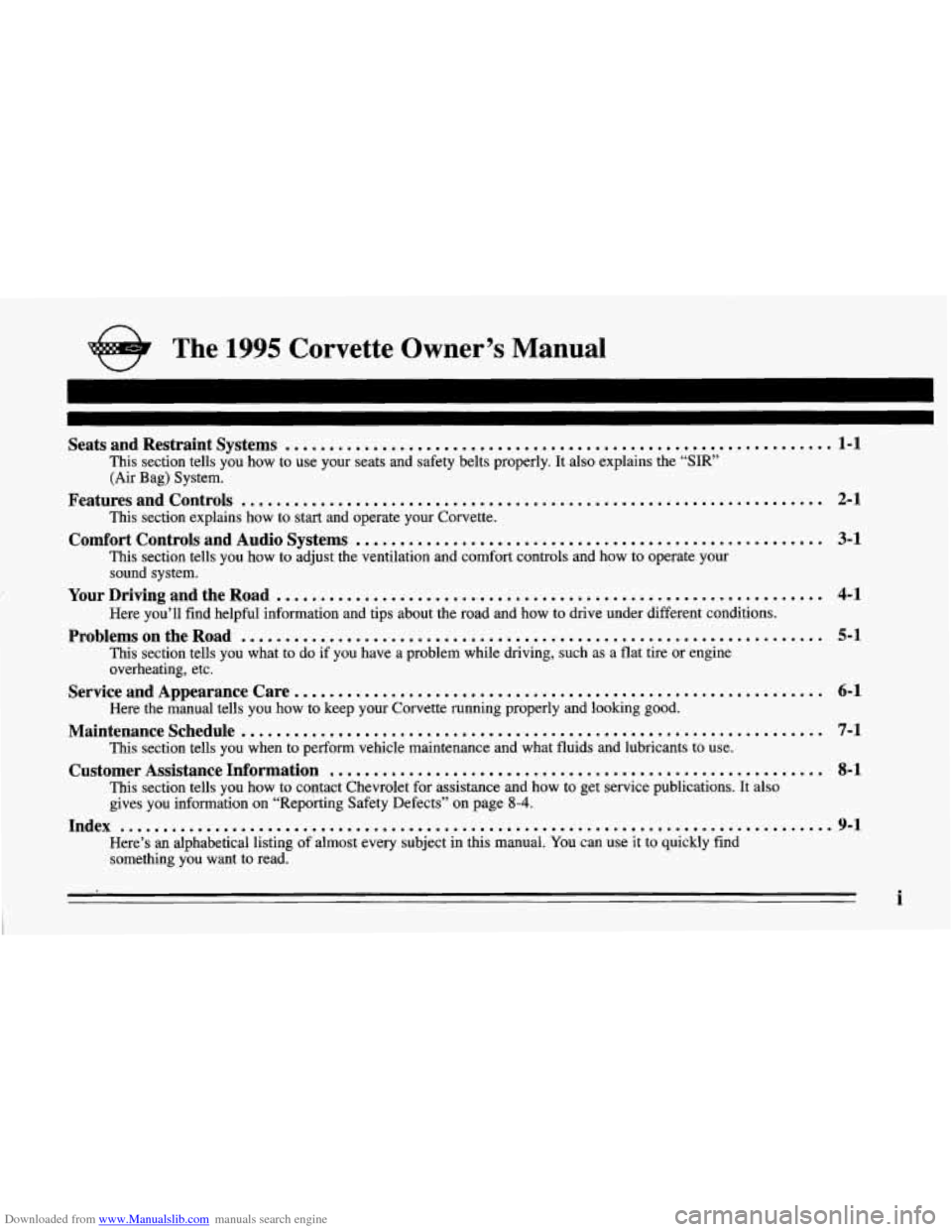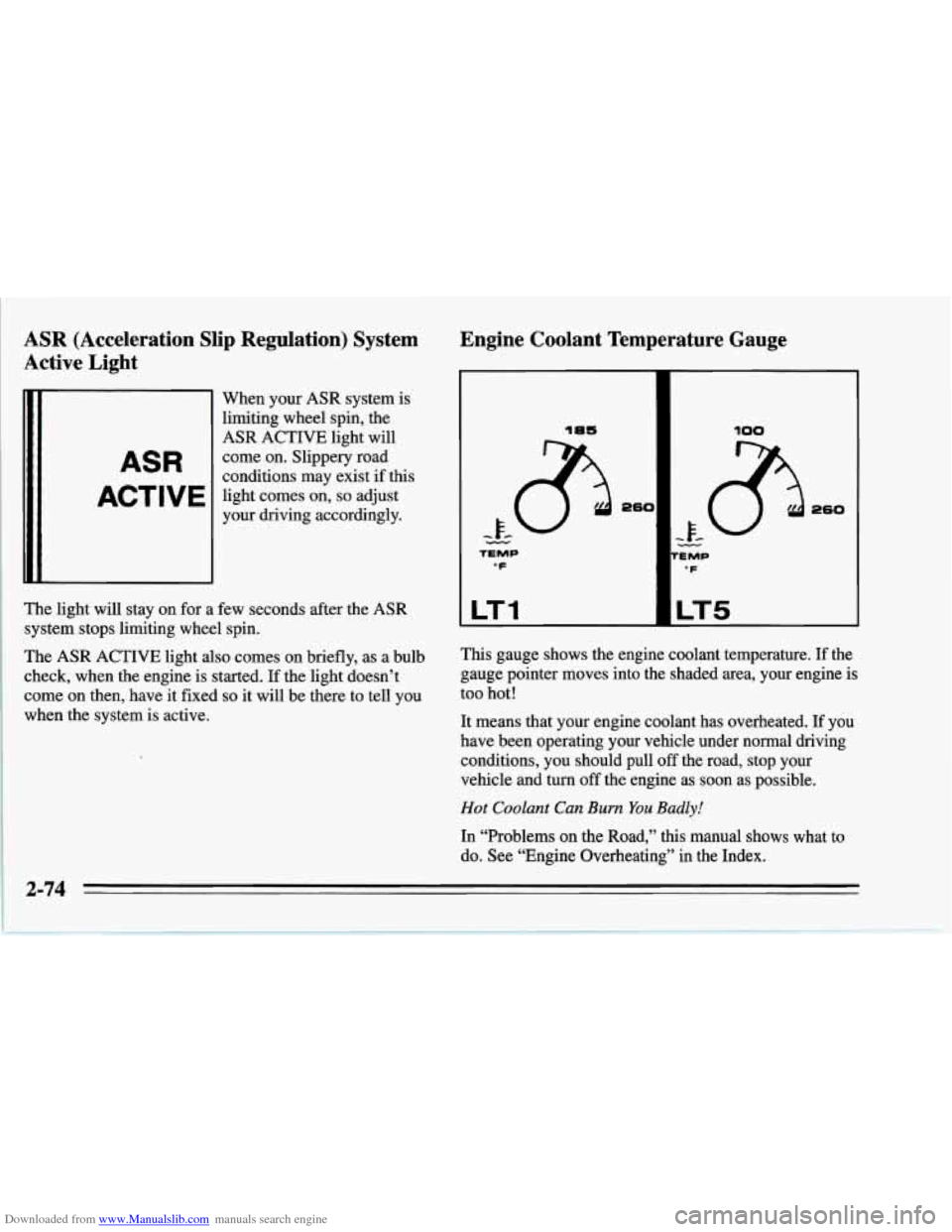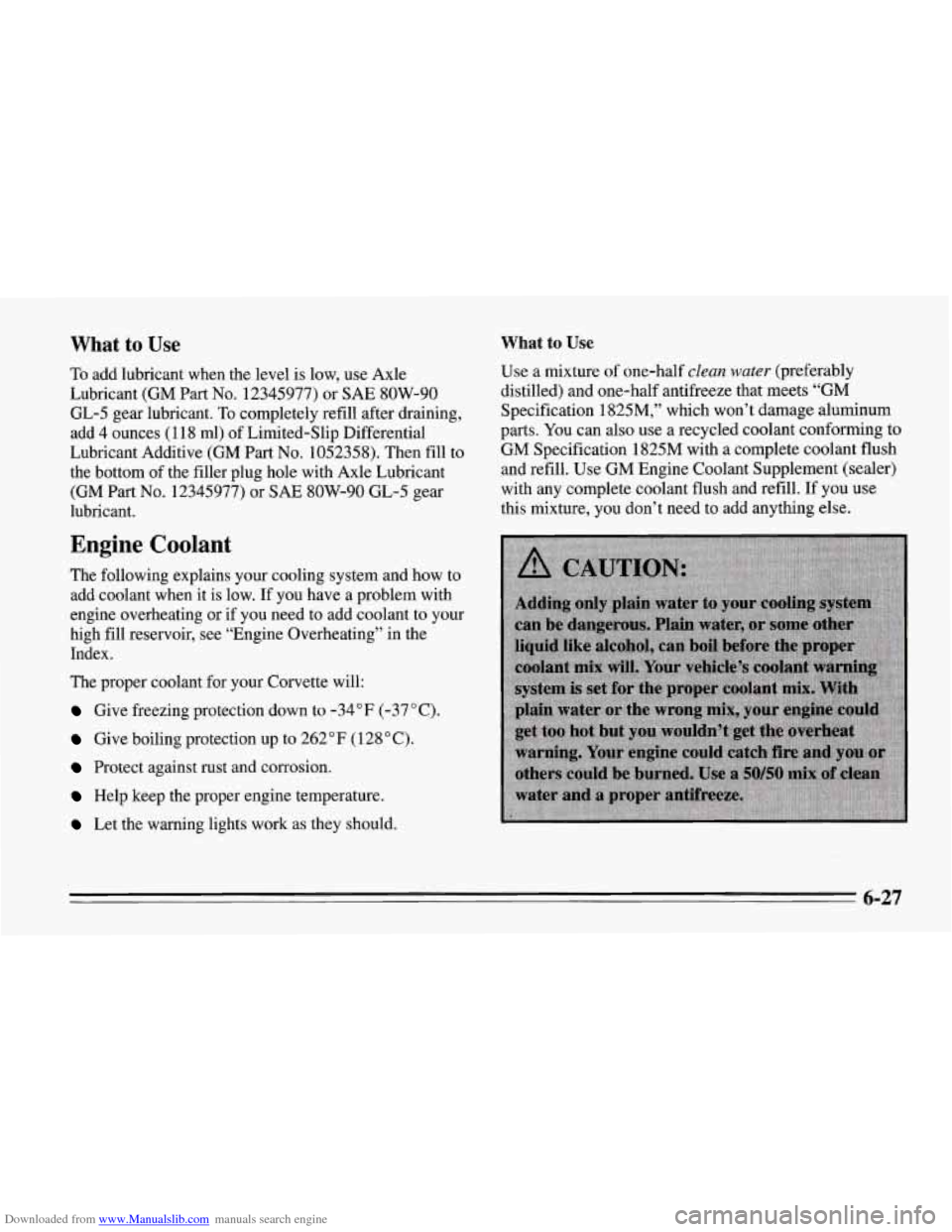Page 2 of 386

Downloaded from www.Manualslib.com manuals search engine n
The -1995 Corvette Owner’s Manual
Seats and Restraint Systems .............................................................. 1-1
This section tells you how to use your seats and safety belts properly. It also explains the “SIR’
(Air Bag) System.
This section explains how to start and operate your Corvette.
This section tells you how to adjust the ventilation and comfort controls and how
to operate your
sound system.
YourDrivingandtheRoad ..............................................................
Here you’ll find helpful information and tips about the road and how to drive under different conditions.
This section tells you what to do if
you have a problem while driving, such as a flat tire or engine
overheating, etc.
Here the manual tells
you how to keep your Corvette running properly and looking good.
Maintenanceschedule ..................................................................
This section tells you when to perform vehicle maintenance and what fluids and lubricants to use.
Customer Assistance Information ........................................................
This section tells you how to contact Chevrolet for assistance and how to get service publications. It also
gives you information on “Reporting Safety Defects” on page
8-4.
FeaturesandControls ..................................................................
Comfort Controls and Audio Systems .....................................................
ProblemsontheRoad ..................................................................
ServiceandAppearanceCare ............................................................
2-1
3-1
4-1
5-1
6- 1
7-1
8-1
Index ........................................................................\
......... 9-1
Here’s an alphabetical listing of almost every subject in this manual. You can use it to quickly find
something you want to read.
i
Page 117 of 386

Downloaded from www.Manualslib.com manuals search engine ASR (Acceleration Slip Regulation) System
Active Light
ASR
ACTIVE
When your ASR system is
limiting wheel spin, the
ASR ACTIVE light will
come on. Slippery road
conditions may exist
if this
light comes on,
so adjust
your driving accordingly.
The light will stay on for a few seconds after the ASR
system stops limiting wheel spin.
The ASR ACTIVE light also comes on briefly, as a bulb
check, when the engine is started. If the light doesn’t
come on then, have it fixed
so it will be there to tell you
when the system is active.
Engine Coolant Temperature Gauge
18s
TEMP
“F
LT1
100
uv
’E MP
‘F
LT5
This gauge shows the engine coolant temperature. If the
gauge pointer moves into the shaded area, your engine is
too hot!
It means that your engine coolant has overheated. If you
have been operating your vehicle under normal driving
conditions, you should pull
off the road, stop your
vehicle and turn
off the engine as soon as possible.
Hot Coolant Can Bum You Badly!
In “Problems on the Road,” this manual shows what to
do. See “Engine Overheating” in the Index.
2-74
Page 118 of 386
Downloaded from www.Manualslib.com manuals search engine For numeric gauge measurements, press the GAUGES
button on the Trip Monitor until COOL appears. The
number that appears next to the fuel gauge is the coolant
temperature. If
LO appears, the temperature is below
32°F (OOC).
,ow Coolant
1
This red light comes on
when the coolant in the
system is
low. You may
LOW
need to add coolant. See
“Engine Overheating” in the
COOLANT Index-
NOTICE:
Driving with the LOW COOLANT light on could
cause your Corvette
to overheat. See “Engine
Overheating” in the Index. Your Corvette could
be damaged, and it wouldn’t be covered by your warranty.
2-75
Page 124 of 386
Downloaded from www.Manualslib.com manuals search engine NOTICE:
Damage to your engine from neglected oil
problems can be costly and
is not covered by your
warranty.
Engine Oil Temperature Gauge
LT1 LT5
This gauge shows your engine oil temperature. Oil
temperature may vary with the type
of driving you do
and weather conditions. If your gauge pointer moves
close to or into the shaded area and stays there, your oil
temperature is too high. Check the engine coolant
temperature and engine oil level. If your engine is too
hot, see “Engine Overheating” in the Index. Your
vehicle may need service; see your dealer.
2-81
Page 206 of 386
Downloaded from www.Manualslib.com manuals search engine Attach a separate safety chain around the outboard end
of each lower control arm.
I I
I NOTICE:
Do not allow chains to contact spring, as damage
to spring could result.
Engine Overheating
You will find an engine coolant temperature gauge on
the instrument cluster and a low coolant light on the
Driver Information Center.
If Steam Is Coming From Your Engine
'I
c
a
5-13
Page 210 of 386
Downloaded from www.Manualslib.com manuals search engine The coolant level should be at or above COLD. If it
isn’t, you may have a leak in the radiator hoses, heater
hoses, radiator, water pump or somewhere else in the
cooling system.
NOTICE:
Engine damage from running your engine
without coolant isn’t covered by your warranty.
If there seems to be no leak, with the engine on check to
see if the electric engine fan(s) are running.
If the engine
is overheating, both fan(s) should be running. If they
aren’t, your vehicle needs service.
How to Add Coolant to the Coolant
Recovery Tank
If you haven’t found a problem yet, but the ,coo,lant level
isn’t at or above the COLD mark, add
a 50MI mixture
of clean water (preferably distilled) and a proper
antifreeze at the coolant recovery tank. (%e “Engine
Coolant” in the Index for more information about the
proper coolant mix.)
5-17
Page 262 of 386

Downloaded from www.Manualslib.com manuals search engine What to Use What to Use
To add lubricant when the level is low, use Axle
Lubricant (GM Part
No. 12345977) or SAE SOW-90
GL-5 gear lubricant.
To completely refill after draining,
add
4 ounces (1 18 ml) of Limited-Slip Differential
Lubricant Additive (GM Part
No. 1052358). Then fill to
the bottom of the filler plug hole with Axle Lubricant
(GM Part
No. 12345977) or SAE 8OW-90 GL-5 gear
lubricant.
Engine Coolant
The following explains your cooling system and how to
add coolant when it is low.
If you have a problem with
engine overheating or if you need to add coolant to your
high fill reservoir, see “Engine Overheating” in the
Index.
The proper coolant for your Corvette will:
Give freezing protection down to -34°F (-37°C).
Give boiling protection up to 262 “F (128 ” C).
Protect against rust and corrosion.
Help keep the proper engine temperature.
Let the warning lights work as they should. Use a mixture
of one-half
clean water (preferably
distilled) and one-half antifreeze that meets
“GM
Specification 1825M,” which won’t damage aluminum
parts.
You can also use a recycled coolant conforming to
GM Specification 1825M with a complete coolant flush
and refill. Use GM Engine Coolant Supplement (sealer)
with any complete coolant flush and refill. If
you use
this mixture, you don’t need to add anything else.
6-27
Page 263 of 386
Downloaded from www.Manualslib.com manuals search engine NOTICE:
If you use an improper coolant mix, your engine
could overheat and be badly damaged. The
repair cost wouldn’t be covered by your
warranty.
Too much water in the mix can freeze
and crack the engine, radiator, heater core and other parts.
Adding Coolant
To Check Coolant
When your engine is cold, check the dipstick on the cap
of the coolant recovery tank. The coolant level should
be at COLD, or a little higher. When your engine is
warm, the level on the dipstick should be up to the HOT,
or a little higher. Your
Corvette also has
a high fill reservoir located at the
right rear of the engine compartment.
If the recovery tank
is very low or empty, also add
coolant to the
high fill reservoir. To add coolant at the
high fill reservoir, see “Engine Overheating” in the
Index.
6-28